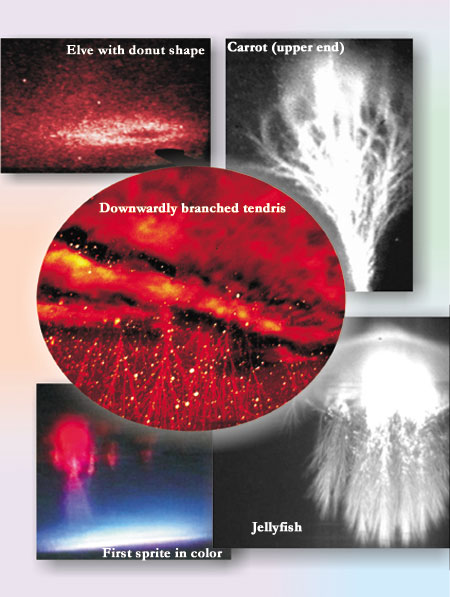Ground Based Sprite Image from Fort Collins, CO 1995 (Courtesy of the Geophysical Institute, the University of Alaska)Sprites are optical phenomena that occur above active thunderstorms.
The name "sprite" was first proposed by Dr. Davis Sentman from the University of Alaska and first used in literature by W.A. Lyons in 1994. He said that the name "sprite" was "well suited to describe their appearance, and is non-judgemental as to the physics of the phenomena". Sentman himself said that the name originated from their “fairy-like qualities” (Sentman and Wescott, 1995) and it is “a term that is succinct and whimsically evocative of their fleeting nature” (Sentman and Wescott, 1996) 
Various Sprite Images (Courtesy of the Geophysical Institute, the University of Alaska) Sprite Properties Sprites are associated with positive cloud-to-ground (CG) lightning discharge, and they last from about 5ms to 300ms(Rodger, 1999). Sprites usually have a column-like composition, with a lot of fine structure. They extend from about 30-40km to about 70-90km, with a primary body at about 50-60km. Their horizontal extent is about 25-50km, with a bright core <10km wide (Rodger 1999). The main upper portion of sprites are red in color, while the lower tendrils go from red to blue with decreasing altitude (Sentman et al. 1995). These colors are caused by the excitation of molecular nitrogen (the brightest lines in the spectrum are in the ranges 650-680nm and 750-780nm). Sprites are directly correlated with positive CG strokes from large thunderclouds (Sentman and Wescott, 1993; Lyons, 1994). These tend to be large discharges (>kA). Only 10% of all lightning is positive CG. Where are Sprites Observed?
What Causes Sprites? Here are three possible candidates for sprite production which I will briefly describe: 1. Quasi-Electrostatic Field 2. Runaway Electron Breakdown 3. Electromagnetic Pulse (EMP) (Almost ruled out for sprite
production, but associated with a related phenomena called Elves)
Model 1: The Quasi-Electrostatic Field 1. The cloud charges up before the lightning discharge inducing a negative shielding layer 2. The positive CG removes positive charge but the negative shielding layer remains over a much longer time scale 3. The negative shielding layer remains after the discharge causing polarization in the atmosphere and a quasi-static E-field. This can me likened to a giant parallel plate capacitor as shown above. This strong E-field causes electrical breakdown producing sprites. Model 2: Runaway Electron Breakdown
In a sufficiently strong electric field, these accelerating electrons produce an avalanche effect that allows the number of electrons to grow exponentially, known as runaway breakdown. Collisional excitation with the relativistic and secondary electrons produce optical emissions seen as sprites (Bell et al., 1995: Roussel-Dupre and Gurevich, 1996; Yukhimuk et al., 1998)
Differentiating between the quasi-electrostatic field and runaway electron models If we measure a low vertical E-field near the sprite, the quasi-electrostatic
field model could be ruled out. The runaway electron model includes the
seeding of high energy electrons by cosmic rays, thus it requires a weaker
vertical E-field to produce sprites. The magnitude of the E-field
we measure will tell us which model is more valid. Hence, the new
HV detector I am designing is an important instrument for an effective
experiment. The detection of bremsstrahlung x-rays produced by cosmic
rays would support the runaway electron model.
Model 3: Electromagnetic Pulse (EMP) The electromagnetic pulse from the return stroke of large lightning
strikes causes electrical breakdown of the high altitude atmosphere above
the thunderstorm(Rowland et al., 1995; Valdiva et al., 1997). Since
the charge is transferred very quickly (0.1ms) during the return stroke,
the EMP is a radiation and inductive field phenomena. Since sprites occur
at least 5ms after the positive CG and the EMP lasts about 1ms after the
positive CG, the EMP model seems to better explain another related
phenomena known as “Elves” which occur 0.35ms after the positive CG.
|